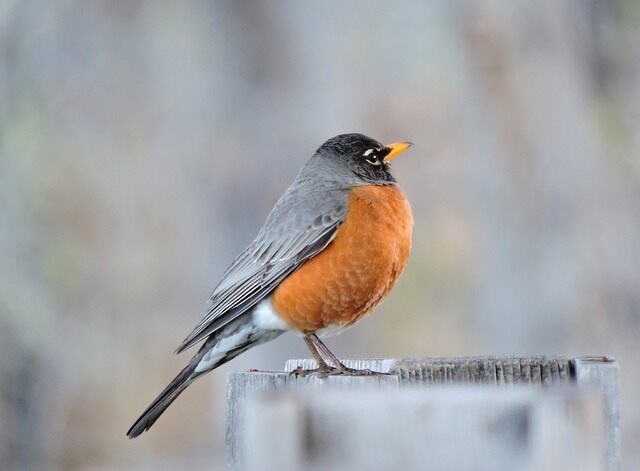Step into the enchanting world of winter birdwatching in Indiana with our immersive guide. As the chill sets in and snowflakes dance in the air, Indiana’s backyards come alive with the vibrant colors and cheerful melodies of our feathered friends.
Join us on a journey through the snowy landscapes and discover the diverse array of winter bird species that call Indiana home during the colder months. From the iconic Northern Cardinal to the elusive Eastern Bluebird, prepare to be captivated by the beauty and wonder of Indiana’s winter avian residents.
25 Backyard Click the Play button below to listen to our podcast:
Table of Contents
- 1 Backyard Winter Birds In Indiana
- 1.1 Northern Cardinal
- 1.2 Downy Woodpecker
- 1.3 Dark-eyed Junco
- 1.4 Blue Jay
- 1.5 White-breasted Nuthatch
- 1.6 Red-bellied Woodpecker
- 1.7 Tufted Titmouse
- 1.8 American Crow
- 1.9 Carolina Chickadee
- 1.10 American Goldfinch
- 1.11 House Sparrow
- 1.12 Mourning Dove
- 1.13 House Finch
- 1.14 European Starling
- 1.15 Song Sparrow
- 1.16 American Robin
- 1.17 Carolina Wren
- 1.18 White-throated Sparrow
- 1.19 American Tree Sparrow
- 1.20 Northern Flicker
- 1.21 Eastern Bluebird
- 1.22 Hairy Woodpecker
- 1.23 Black-capped Chickadee
- 1.24 Pileated Woodpecker
- 1.25 Red-winged Blackbird
- 2 Author
Backyard Winter Birds In Indiana
Northern Cardinal
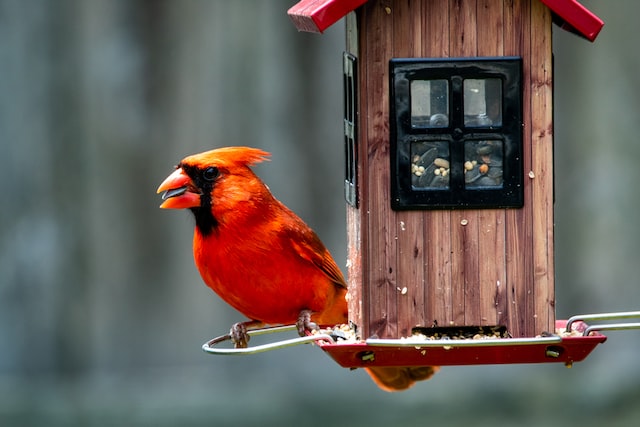
- Length: 8.3-9.1 in (21-23 cm)
- Weight: 1.5-1.7 oz. (42-48 g)
- Wingspan: 9.8-12.2 in (25-31 cm)
- Scientific Name: Cardinalis cardinalis
- Frequency of Occurrence: 54.69% (Statistic by: eBird)
- Maps: Range Map – Sightings Map
- Sounds: Calls and Sounds
- Where To Find Them: In winter, Northern Cardinals can be found in woodlands, swamps, and along the edges of forests throughout Indiana. They are also common in residential areas and city parks. Cardinals are not migratory birds, so they remain in their territories year-round.
- How to Attract Them: To attract cardinals, you’ll need to provide them with food and water. A bird feeder filled with sunflower seeds is a great option, and adding a birdbath will give them a place to drink and bathe.
General Information: The Northern Cardinal is a North American bird in the genus Cardinalis.They have a distinctive crest on their head and a black mask. Male cardinals are a vibrant red color, while females are a duller reddish-brown color. Both sexes have reddish beaks and brown eyes. The Northern Cardinal is found in the eastern United States, from southern Canada to northern Mexico.
They are permanent residents in most of their range, although some birds in the northernmost parts of their range may migrate south for the winter. The Northern Cardinal is an adaptable bird and is found in a variety of habitats, including forests, woodlands, gardens, and swamps. The diet of the Northern Cardinal consists mainly of seeds and fruits, although they will also eat insects, especially in the summer. Cardinals are often seen feeding on bird feeders.
Related: Cardinal Bird Facts Every Birdwatcher Should Know!
Downy Woodpecker

- Length: 5.5-6.7 in (14-17 cm)
- Weight: 0.7-1.0 oz. (21-28 g)
- Wingspan: 9.8-11.8 in (25-30 cm)
- Scientific Name: Picoides pubescens
- Frequency of Occurrence: 45.38%
- Maps: Range Map – Sightings Map
- Sounds: Calls and Sounds
- Where To Find Them: The first location is Brown County State Park. This park is located in southern Indiana, and it has a variety of habitats including forests, fields, and wetlands. The second location is Deam Lake State Recreation Area. This park is located in central Indiana, and it has a variety of habitats including forests, lakes, and wetlands. The third location is Tippecanoe River State Park.
- How to Attract Them: The best way to attract Downy Woodpeckers to your backyard is by providing them with food and shelter. Suitable foods include suet, sunflower seeds, peanuts, and insect larvae. You can also put up a nesting box for them to use as shelter. Be sure to place it at least 10 feet off the ground in a tree or on a pole. Downy Woodpeckers are shy birds, so be patient when waiting for them to visit your backyard. Once they become accustomed to your presence, they will be more likely to approach you.
General Information: The Downy Woodpecker is a small woodpecker found throughout North and Central America. It is the most widespread woodpecker in the continent, and one of the most widespread birds in the world. The Downy Woodpecker is a common bird in woodlands, parks, and gardens. It is a small bird, with a black and white plumage, and a short tail.
The Downy Woodpecker is an insectivore, and feeds on ants, beetles, and other insects. It also eats fruit, nuts, and seeds. The Downy Woodpecker is a cavity nester, and excavates its own nest hole in trees. The Downy Woodpecker is a social bird, and often forms flocks with other birds.
Related: How to Attract Downy Woodpeckers to Your Yard? (Easy!)
Dark-eyed Junco
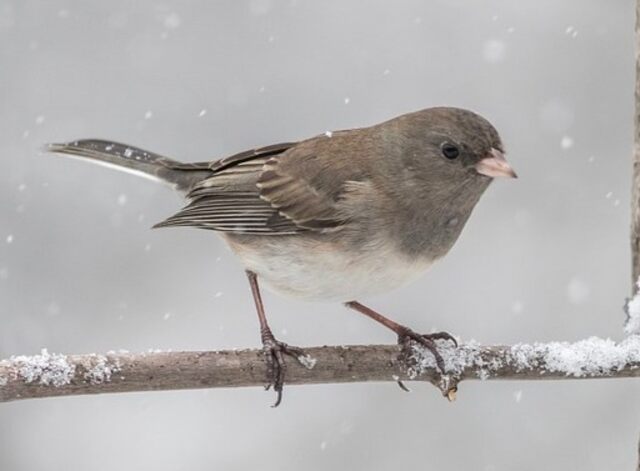
- Length: 5.5-6.3 in (14-16 cm)
- Weight: 0.6-1.1 oz. (18-30 g)
- Wingspan: 7.1-9.8 in (18-25 cm)
- Scientific Name: Junco hyemalis
- Frequency of Occurrence: 44.52%
- Maps: Range Map – Sightings Map
- Sounds: Calls and Sounds
- Where To Find Them: If you’re interested in seeing a Dark-eyed Junco this winter, there are a few locations in Indiana where they are commonly found. One good place to look is Brown County State Park, which is located in southern Indiana. Another promising spot is McCormick’s Creek State Park, which is situated in the central part of the state.
- How to Attract Them: Juncos prefer seed that is found on or near the ground, so place a feeder accordingly. You can also put out a small dish of water for them to drink from. Provide some shelter for the juncos by placing evergreen branches or shrubs nearby. This will give them a place to hide from predators and escape the cold winds.
General Information: The Dark-eyed Junco is a small sparrow with a slate-gray back and wings, and a white belly. The adult male has a black hood and a white throat. The adult female is similar, but with a gray hood and throat. The juveniles are brown above and pale below, with brown streaks on their back and wings.
The Dark-eyed Junco is found in North and Central America. In the summer, it breeds in the mountainous regions of Canada and the western United States. In the winter, it is found in the southern United States and Mexico. The Dark-eyed Junco prefers open woodlands, but it can also be found in forests, parks, and gardens. It feeds on insects, seeds, and berries.
Related: Fun Facts About Dark-eyed Juncos
Blue Jay
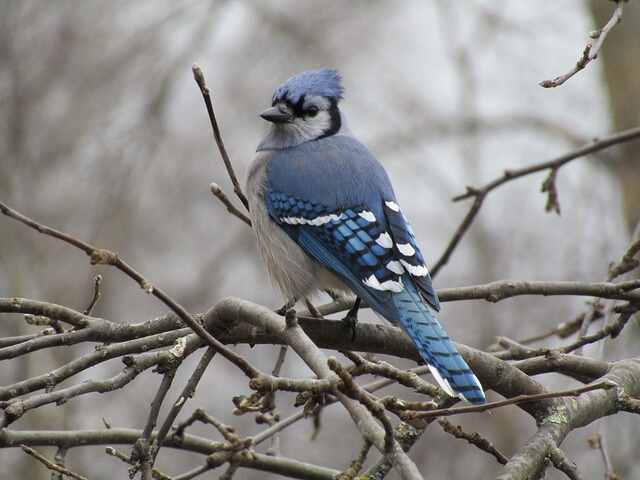
- Length: 9.8-11.8 in (25-30 cm)
- Weight: 2.5-3.5 oz. (70-100 g)
- Wingspan: 13.4-16.9 in (34-43 cm)
- Scientific Name: Cyanocitta cristata
- Frequency of Occurrence: 41.33%
- Maps: Range Map – Sightings Map
- Sounds: Calls and Sounds
- Where To Find Them: During the winter months, Blue Jays can be found in many different locations throughout Indiana. They are often seen in wooded areas near ponds and streams, as well as in open fields and meadows.
- How to Attract Them: First, make sure you have a food source for them. Blue jays are mostly seed eaters, so put out a bird feeder filled with sunflower seeds or peanuts. You can also put out a suet feeder with beef fat or other fatty foods. Second, provide some water for them to drink and bathe in. A simple birdbath will do, or you can get creative and build a homemade waterfall or pond. Make sure the water isn’t too deep and is maintained clean.
General Information: The Blue Jay is a member of the Corvidae family. It is native to North America and ranges from southern Canada to northern Mexico. The main habitat of the Blue Jay is in woods, gardens, and parks. It also occurs in urban areas.
The typical diet of the Blue Jay includes acorns, nuts, berries, insects, and small reptiles.The Blue Jay is a very vocal bird and is known for its mimicry of other sounds. It also has a strong memory and impressive intelligence. The Blue Jay is a popular bird in North America and is the official bird of the province of Prince Edward Island.
Related: What Attracts Blue Jays to your Yard?(Expert Tips)
White-breasted Nuthatch
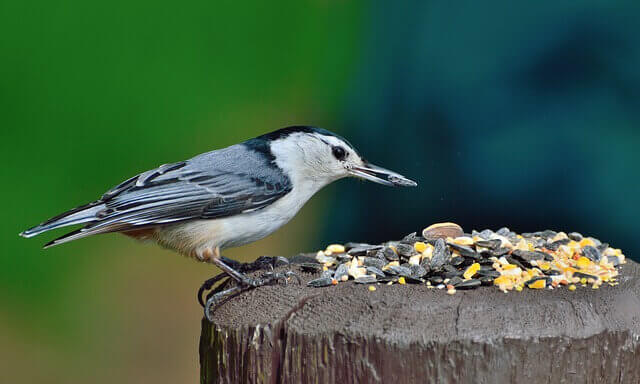
- Length: 5.1-5.5 in (13-14 cm)
- Weight: 0.6-1.1 oz. (18-30 g)
- Wingspan: 7.9-10.6 in (20-27 cm)
- Scientific Name: Sitta carolinensis
- Frequency of Occurrence: 40.54%
- Maps: Range Map – Sightings Map
- Sounds: Calls and Sounds
- Where To Find Them: In winter, the White-breasted Nuthatch can be found in woodlands, parks, and residential areas. Look for this little bird clinging to tree trunks and branches as it searches for food.
- How to Attract Them: If you’re hoping to attract White-breasted Nuthatches to your yard this winter, the best bet is to put out a variety of foods that these birds like to eat. Nuthatches are especially fond of peanuts and sunflower seeds, so offer these foods in a feeder that’s designed for small birds. You can also put out a suet cake, which will provide the birds with much-needed energy on cold days. Make sure to place your bird feeders in an area where there are trees or shrubs nearby.
General Information: The White-breasted Nuthatch is a small songbird with a black cap and a white face. It has a blue-gray back and wings, and a white breast and belly. The nape and sides of the head are black, and there is a black stripe through the eye. The bill is black, and the legs and the feet of the White-breasted Nuthatch are gray. The White-breasted Nuthatch is a bird occurs at both deciduous and mixed forests throughout North America.
It is also found in urban and suburban areas with trees. The White-breasted Nuthatch is a cavity nesting bird. It will nest in a hole in a tree, or in a nest box. The female lays 4-8 eggs. Both parents feed the young. The White-breasted Nuthatch eats insects, nuts, and seeds. It will often cling to a tree trunk and search for food. It will also hang upside down to eat.
Related: How to Attract Nuthatches to your Backyard? Expert Tips!
Red-bellied Woodpecker
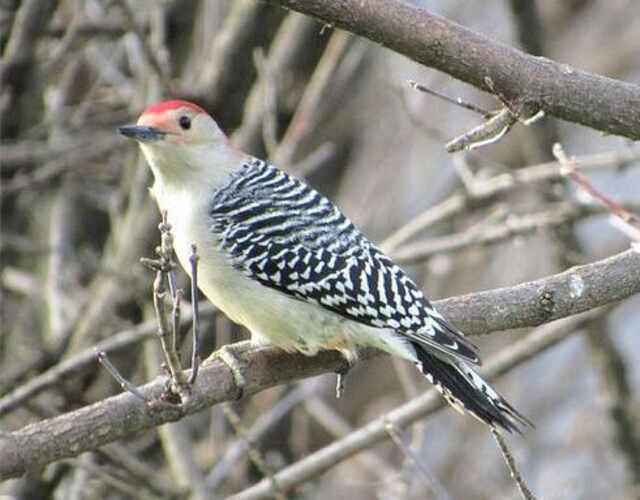
- Length: 7.0-9.4 in (24 cm)
- Weight: 2.0-3.2 oz. (56-91 g)
- Wingspan: 13.0-16.5 in (33-42 cm)
- Scientific Name: Melanerpes carolinus
- Frequency of Occurrence: 39.63%
- Maps: Range Map – Sightings Map
- Sounds: Calls and Sounds
- Where To Find Them: Although the red-bellied woodpecker is a common bird in Indiana, it is not always easy to find one in the winter. The best places to look for these birds are in wooded areas near forests or swamps. They will also sometimes be found in urban areas, but this is less common.
- How to Attract Them: If you’re hoping to attract red-bellied woodpeckers to your backyard this winter, there are a few things you can do. First, make sure you have a good selection of bird seed available. These birds are particularly fond of sunflower seeds, so if you have some of those on hand, you’re more likely to see them at your feeder. You should also put out suet cakes or other high-fat foods to help them stay warm in the cold weather.
General Information: The Red-bellied Woodpecker is a medium-sized woodpecker found in woods and forests across eastern North America. The Red-bellied Woodpecker’s breeding range extends from southeastern Canada to the Gulf of Mexico and from the Atlantic coast to the Great Plains. They are permanent residents in the southern part of their range, but birds in the northern part of their range may migrate south in the winter.
These birds typically nest in trees, often in dead or dying trees. Their diet consists primarily of insects, although they will also eat fruits, nuts, and other plant material. They typically forage by climbing up tree trunks and branches, using their strong bills to drill into the bark to find insects. They will also catch insects in mid-air. Red-bellied Woodpeckers will sometimes store food in tree crevices to eat later.
Related: How to Attract Red-bellied Woodpeckers to your Yard?
Tufted Titmouse
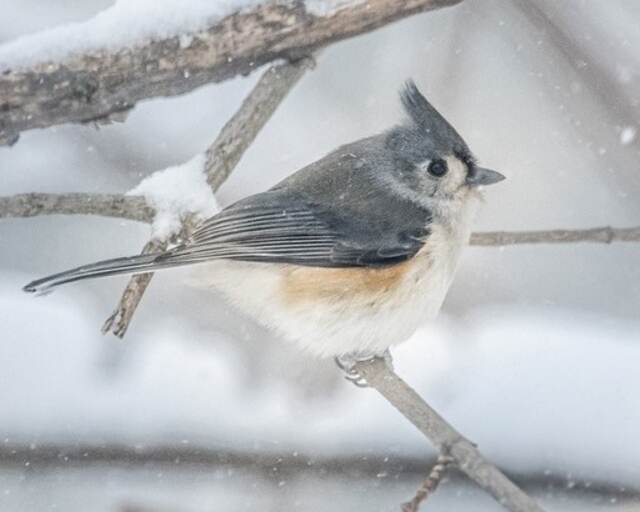
- Length: 5.5-6.3 in (14-16 cm)
- Weight: 0.6-0.9 oz. (18-26 g)
- Wingspan: 7.9-10.2 in (20-26 cm)
- Scientific Name: Baeolophus bicolor
- Frequency of Occurrence: 38.47%
- Maps: Range Map – Sightings Map
- Sounds: Calls and Sounds
- Where To Find Them: In winter, tufted titmice typically form small flocks and can be found in both deciduous and coniferous forests. While they will occasionally visit bird feeders, these birds are more likely to be found in natural areas such as state parks or nature preserves.
- How to Attract Them: In winter, they are attracted to backyard bird feeders. Here are some tips on how to attract them to your backyard in winter: Put out a bird feeder filled with black oil sunflower seeds. Place the bird feeder in a spot where it is sheltered from the wind and has good visibility. Clean the bird feeder regularly to prevent buildup. Offer other food sources such as suet cakes or fruit slices to attract different types of birds.Watch for the Tufted Titmouse at dawn and dusk when they are most active.
General Information: The Tufted Titmouse (Baeolophus bicolor) is a small songbird found in North America. This bird is a non-migratory bird and is a permanent resident in its range, which is from southeastern Canada to central Mexico. The Tufted Titmouse is a common bird in woodlands, forests, and suburban areas. It is a fairly small bird, with a body length of 5.5-6.3 inches and a wingspan of 7.9-10.2 inches.
The Tufted Titmouse is grayish-brown on its upperparts and whitish on its underparts. They have a black head with a white forehead and a grayish-brown crest. It also has black eyes and a black bill. The Tufted Titmouse is found in a variety of habitats, including deciduous and evergreen forests, woodlands, and suburban areas. This bird is a non-migratory bird and is a permanent resident in its range.
Related: How to Attract Tufted Titmouse to my Yard? (Explained)
American Crow

- Length: 15.8-20.9 in (40-53 cm)
- Weight: 11.2-21.9 oz. (316-620 g)
- Wingspan: 33.5-39.4 in (85-100 cm)
- Scientific Name: Corvus brachyrhynchos
- Frequency of Occurrence: 35.86%
- Maps: Range Map – Sightings Map
- Sounds: Calls and Sounds
- Where To Find Them: During the winter months, American crows can be found in a variety of locations throughout Indiana. In the northern part of the state, they are often seen near Lake Michigan, while in southern Indiana they are more likely to be found in wooded areas near rivers and streams. In central Indiana, crows can be found in both urban and rural areas.
- How to Attract Them: First, provide a food source for the crows. Crows are omnivorous and will eat just about anything, so offer up a variety of foods such as nuts, fruits, and even small pieces of meat. You can also put out a bird feeder specifically for crows. Second, give them a place to roost. Crows like to roost in large numbers, so provide them with a large tree or other structure that they can perch on. It’s also important to make sure that there are no predator threats in the area where they’ll be roosting.
General Information: The American Crow is a species of bird that is found in North America. The American Crow’s distribution range extends from Alaska and Canada to the eastern and southern United States. The American Crow is a highly adaptable bird and can be found in a variety of habitats, including forests, grasslands, and urban areas. The American Crow is an opportunistic feeder, and its diet varies depending on what is available.
The American Crow typically feeds on insects, small mammals, fruits, and nuts. They are social birds and often form large flocks. The American Crow is a vocal bird, and its call is a loud, harsh “caw.” The American Crow is a common bird and is not considered to be threatened or endangered.
Related: How To Attract Crows To Your Backyard: Expert Tips!
Carolina Chickadee

- Length: 4.7-6.0″ in (12.0-15.2 cm)
- Weight: 0.3-0.5 oz (9-14 g)
- Wingspan: 6.3-8.3 in (16-21 cm)
- Scientific Name: Poecile carolinensis
- Frequency of Occurrence: 34.75%
- Maps: Range Map – Sightings Map
- Sounds: Calls and Sounds
- Where To Find Them: In winter, they often form small flocks with other chickadees and nuthatches, moving from tree to tree in search of insects hidden in bark crevices. You’re most likely to see Carolina chickadees in woodlands, forests, or city parks.
- How to Attract Them: One of the best ways to attract Carolina Chickadees is to provide them with a food source. Chickadees are attracted to sunflower seeds, Niger seeds, and suet. You can purchase a tube feeder that is designed specifically for small birds like chickadees, or you can simply put out a bowl of seed mix on a table or shelf. Another way to attract Carolina Chickadees is to provide them with shelter.
General Information: The Carolina Chickadee is a small, sprightly bird found in forests throughout the southeastern United States. Although they are year-round residents in most of their range, Carolina Chickadees are one of the many bird species that visit North Carolina during the winter months. Carolina Chickadees are small birds, measuring only about 5 inches in length.
They have dark gray upperparts and a white chest with a black cap and bib. Their call is a distinctive “chick-a-dee-dee-dee” which is how they got their name. Carolina Chickadees are found in woodlands, both deciduous and evergreen. They prefer forest edges and thickets, as well as areas with lots of trees and shrubs. Their diet consists mostly of insects, but they will also eat seeds and berries.
Related: Carolina Chickadees – 9 Best Ways To Attract Them Fast!
American Goldfinch
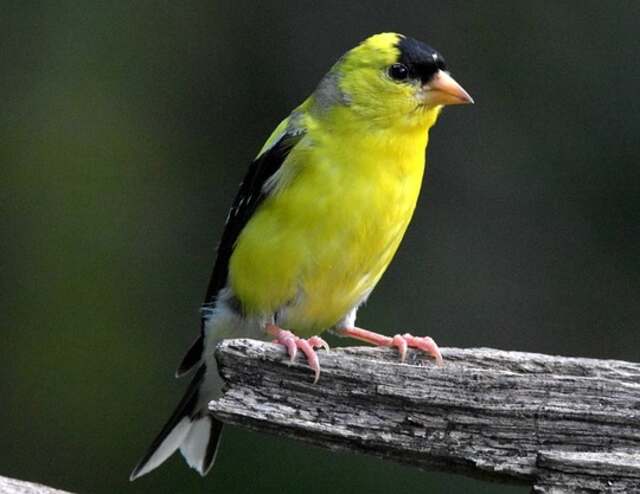
- Length: 4.3-5.1 in (11-13 cm)
- Weight: 0.4-0.7 oz. (11-20 g)
- Wingspan: 7.5-8.7 in (19-22 cm)
- Scientific Name: Spinus tristis
- Frequency of Occurrence: 34.70%
- Maps: Range Map – Sightings Map
- Sounds: Calls and Sounds
- Where To Find Them: The American Goldfinch can be found in various locations throughout Indiana during the winter months. These birds are typically seen in open areas such as fields or meadows, and they often form flocks with other goldfinches. While they are not particularly shy, they can be difficult to spot due to their drab plumage. However, their bright yellow coloration becomes more visible during the springtime when they are actively breeding.
- How to Attract Them: American goldfinches love thistle seed and Niger seed. You can purchase these at your local bird store or online. Put up a feeder. A thistle feeder or a tube feeder with small holes works best. Be sure to place it in a spot where there are no trees or bushes nearby, as the goldfinches like to perch on top of the feeders while they eat.
General Information: The American Goldfinch is a small songbird that is found throughout North America. This bird has a very large range and can be found in nearly every habitat, from forests to grasslands to urban areas. The goldfinch is a very adaptable bird and can even live in areas where there are no trees, such as on the prairie. They are seed-eaters and its diet consists mainly of small seeds from plants, and is occasionally known to eat insects, especially in the summer.
The American Goldfinch is a social bird and often forms flocks with other goldfinches or other small songbirds. Thy are very active birds that are constantly on the move, flitting about in search of food. The goldfinch is also a very vocal bird and has a distinctive song that is often heard in the spring and summer, but seen throughout its range in winter, but they are much less vocal during this time.
Related: Interesting American Goldfinch Facts You Need to Know!
House Sparrow
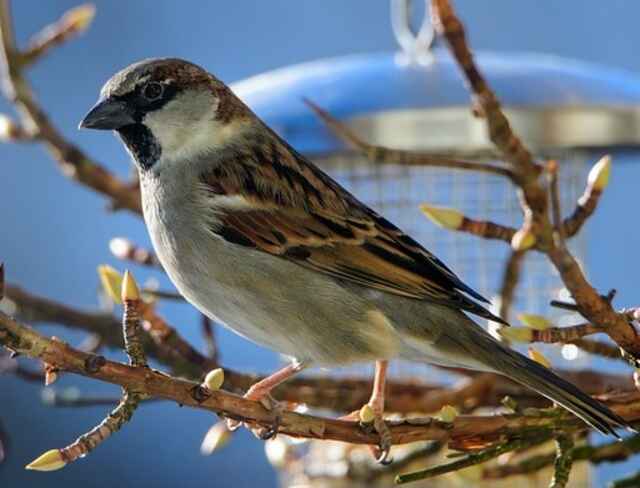
- Length: 5.9-6.7 in (15-17 cm)
- Weight: 0.9-1.1 oz (27-30 g)
- Wingspan: 7.5-9.8 in (19-25 cm)
- Scientific Name: Passer domesticus
- Frequency of Occurrence: 33.36%
- Maps: Range Map – Sightings Map
- Sounds: Calls and Sounds
- Where To Find Them: In Indiana, they are commonly found in urban and suburban areas during the winter months.
- How to Attract Them: One of the best ways to attract house sparrows to your backyard in winter is by providing them with a food source. One way to do this is to offer them a bird feeder filled with their favorite seeds, such as sunflower or nyjer seed. You can also put out a shallow dish of water for them to drink from and bathe in. Another way to attract house sparrows is by providing them with shelter. This can be in the form of a nesting box or roosting box placed in your yard.
General Information: The House Sparrow is a common bird found throughout most of the world. They are particularly fond of human settlement and can be found in cities, suburbs, and rural areas alike. The House Sparrow is a small bird, with males typically measuring between 16 and 18 cm in length and females slightly smaller at 14-16 cm. They have brown upperparts with black streaks on their back and wings, and white underparts.
The male House Sparrow has a grayish-brown cap with a black stripe running through it, while the female has a brown cap with no stripe. Both sexes have a dark spot on their throat. House Sparrows are seed-eaters and will also consume insects, especially during the breeding season when they need to feed their young. In winter, they often visit bird feeders in search of food.
Related: How to Attract Sparrows to your Backyard? (Like A Pro)
Mourning Dove
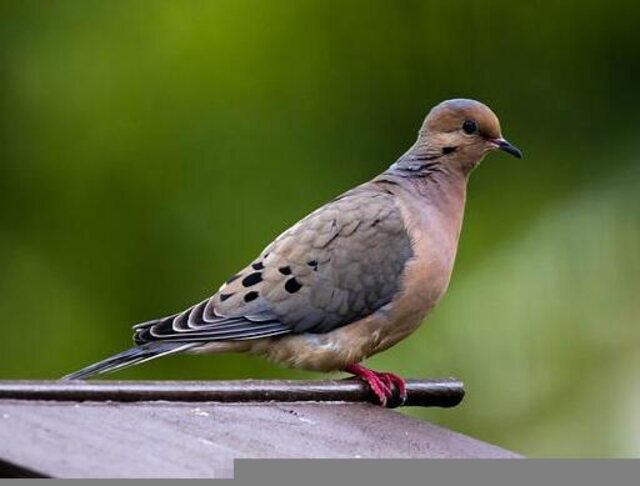
- Length: 9.1-13.4 in (23-34 cm)
- Weight: 3.4-6.0 oz. (96-170 g)
- Wingspan: 17.7 in (45 cm)
- Scientific Name: Zenaida macroura
- Frequency of Occurrence: 32.90%
- Maps: Range Map – Sightings Map
- Sounds: Calls and Sounds
- Where To Find Them: Mourning Doves are found in many different locations throughout Indiana during the winter months. One of the most popular places to find them is at Lake Monroe, where they can often be seen perching on trees or power lines. They can also be found in other areas such as parks, woods, and farmland.
- How to Attract Them: Mourning Doves are attracted to a variety of backyard feeders in winter. Here are a few tips on how to attract them to your backyard: Place a feeder near a window where you can watch them up close. Use a feeder that has multiple perches so more than one bird can feed at a time. Fill the feeder with a high quality seed mix that includes sunflower seeds, safflower seeds, and millet. Keep the feeder clean and free of debris to prevent disease transmission. Provide fresh water for drinking and bathing on a daily basis. Offer shelter from the wind and cold weather by placing the feeder near bushes or trees.
General Information: The Mourning Dove is a North American bird species. The bird is named for its mourning call. The adult Mourning Dove has grayish-brown upperparts and pale gray underparts. The wings are pointed and have black spots, and the tail is long and pointed. The bill is black and the legs are pinkish-red. The adult Mourning Dove is about 9.1-13.4 in (23-34 cm) in length.
The Mourning Dove breeds across most of North America. The bird nests in trees, bushes, or on the ground. The female lays 2 white eggs. Both parents feed the young birds crop milk also known as “pigeon milk”. The Mourning Dove mainly feeds on seeds, fruits, and insects. Seeds make up about 80% of the diet.
Related: 25 Fun Facts About Mourning Doves (A Complete Guide!)
House Finch
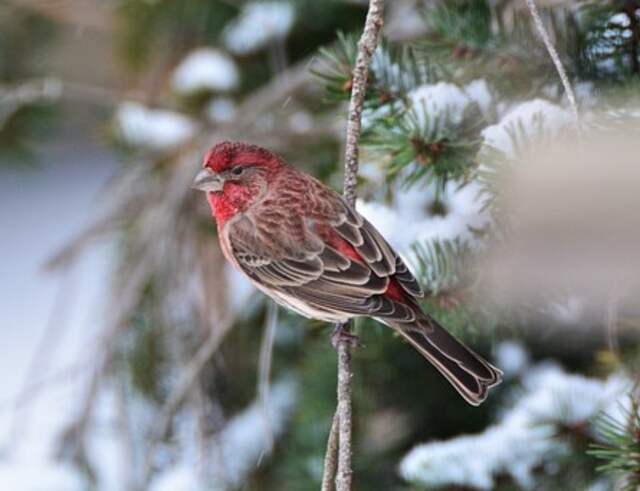
- Length: 5.1-5.5 in (13-14 cm)
- Wingspan: 7.9-9.8 in (20-25 cm)
- Weight: 0.6-0.9 oz. (16-27 g)
- Scientific Name: Haemorhous mexicanus
- Frequency of Occurrence: 31.73%
- Maps: Range Map – Sightings Map
- Sounds: Calls and Sounds
- Where To Find Them: During the winter months, they are more likely to be found in southernmost parts of Indiana near the Ohio River. This is likely due to the fact that these areas offer more food options and shelter from the cold weather.
- How to Attract Them: The best way to attract house finches to your backyard is by providing them with food and shelter. They love to eat sunflower seeds, so try putting out a bird feeder filled with sunflower seeds. You can also put out a bird bath for them to drink from and take a dip in.
General Information: The House Finch (Haemorhous mexicanus) is a bird in the finch family that is native to western North America. The average House Finch is about 5.5 inches long with a wingspan of about 8 inches. The males are typically a brighter red than the females, but both genders have streaked brown upperparts and buff underparts.
The House Finch can be found in open woodlands, gardens, and urban areas across the western United States, Mexico, and parts of Canada. They prefer areas with trees or shrubs for nesting, but will also nest in cavities in walls or buildings. The diet of the House Finch consists mainly of seeds and fruits, but they will also eat insects. In urban areas, they often eat birdseed from feeders as well as garbage and pet food.
Related: How to Attract House Finch to your Yard? (Easy & Fast)
European Starling
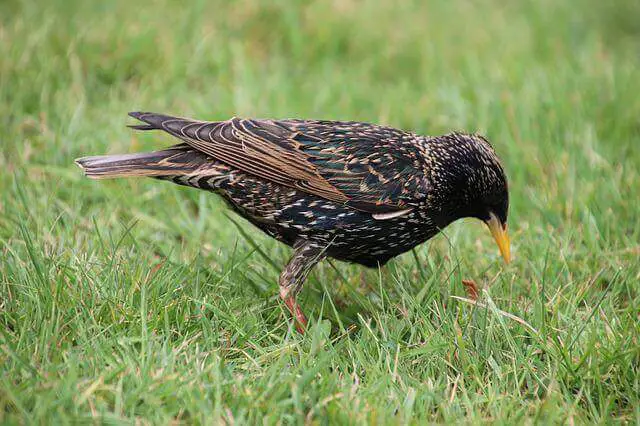
- Length: 7.9-9.1 in (20-23 cm)
- Weight: 2.1-3.4 oz. (60-96 g)
- Wingspan: 12.2-15.8 in (31-40 cm)
- Scientific Name: Sturnus vulgaris
- Frequency of Occurrence: 31.45%
- Maps: Range Map – Sightings Map
- Sounds: Calls and Sounds
- Where To Find Them: European Starlings are found in many different locations throughout Indiana during the winter months. Some of the more common areas include farmland, open woods, and suburban areas. European Starlings typically roost in large flocks, often in trees or on buildings. In rural areas, they may be found roosting in barns or other structures.
- How to Attract Them: Put out a birdfeeder: Starlings are attracted to birdfeeders that offer a variety of foods, such as seed mix, berries, and suet. Create a water source: Starlings need access to water, so consider putting out a birdbath or small fountain. Offer nesting materials: Starlings will build nests in trees or bushes, so make sure to provide them with plenty of twigs, grasses, and other materials. By following these tips, you can bring some extra beauty and life to your yard this winter!
General Information: The European Starling (Sturnus vulgaris) is a medium-sized passerine bird in the starling family. It is about 20 cm long and has black feathers with a metallic sheen. The bill is yellow, and its legs are pink. The adult male has white spots on its wings. The female is similar to the male but lacks the white wing spots. Juveniles have browner plumage.
This species breeds in Europe, Asia and North Africa. It is resident in southern and western Europe but northern birds migrate south for the winter. It occurs in a variety of habitats including farmland, parks, gardens and urban areas. The European Starling eats insects, earthworms, berries and fruits. It forages on the ground or in trees for food items.
Related: How To Attract European Starlings To Your Yard Fast?
Song Sparrow
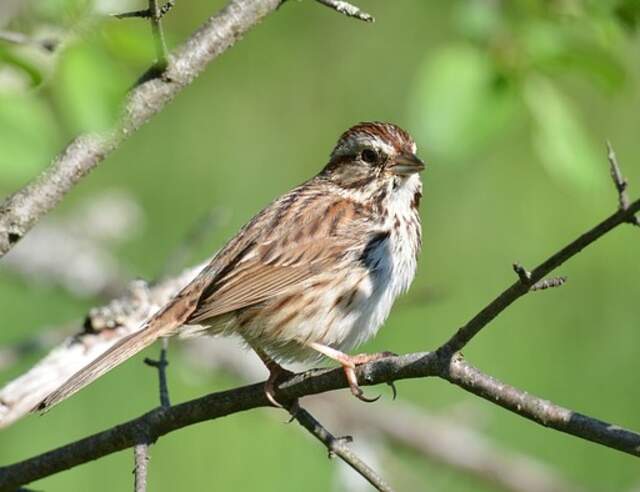
- Length:4.7-6.7 in (12-17 cm)
- Weight: 0.4-1.9 oz. (12-53 g)
- Wingspan: 7.1-9.4 in (18-24 cm)
- Scientific Name: Melospiza melodia
- Frequency of Occurrence: 25.72%
- Maps: Range Map – Sightings Map
- Sounds: Calls and Sounds
- Where To Find Them: In winter, they are typically found in woodlands and brushy areas, as well as along rivers and lakes. Some of the best places to look for them are state parks like Turkey Run and Shades, which offer a variety of habitats for songbirds.
- How to Attract Them: To provide food for the song sparrows, try putting out a bird feeder with black oil sunflower seeds. You can also provide them a bowl for water so they can bathe and drink in. For shelter, try putting up a nesting box or creating a brush pile for them to hide in. By providing food and shelter, you can attract song sparrows to your backyard all winter long!
General Information: The Song Sparrow (Melospiza melodia) is a medium-sized sparrow with streaked brown plumage. The bird ranges from 5.5 to 7.1 inches in length and has a wingspan of 8.7 to 10.2 inches. The adult Song Sparrow weighs between 20 and 28 grams. The bird’s range extends across most of North America, from Alaska to Newfoundland in the north, and south to central Mexico. The preferred habitat of the Song Sparrow is open country with some trees or shrubs nearby, although the bird will also inhabit more urban areas such as parks and gardens.
Their diet consists mostly of insects and seeds. In the summer, they eat mostly insects, including beetles, grasshoppers, crickets, ants, flies, wasps, and caterpillars. The bird nests in a cup-shaped nest built from grass, twigs, bark strips, rootlets, and other plant material, which is usually located on the ground under cover of vegetation.
American Robin
- Length: 7.9-11.0 in (20-28 cm)
- Weight: 2.7-3.0 oz (77-85 g)
- Wingspan: 12.2-15.8 in (31-40 cm)
- Scientific Name: Turdus migratorius
- Frequency of Occurrence: 22.38%
- Maps: Range Map – Sightings Map
- Sounds: Calls and Sounds
- Where To Find Them: American Robins can be found throughout Indiana throughout the winter months. Brown County State Park, Goose Pond Fish and Wildlife Area, and Morgan-Monroe State Forest are among the most popular destinations.
- How to Attract Them: If you live in an area where Robins are present in winter and would like to attract them to your yard, here are a couple of tips: Put out a bird bath or shallow dish filled with fresh water. Robins are attracted to moving water and will use a bird bath for both drinking and bathing. Provide a variety of fruits for them to eat. Berries are their favorite food, but they will also eat grapes, raisins, and other dried fruits.
General Information: The American Robin is a migratory bird that can be found in North America. The bird is most commonly seen in the eastern United States, but its range extends from Alaska to Newfoundland. The American Robin is a habitat generalist and can be found in a variety of habitats including forests, fields, and even urban areas.
The diet of the American Robin consists primarily of insects, but the bird will also eat berries and fruits. In winter, the American Robin is one of the few birds that remain in North America. The bird’s range contracts during this time and it can be difficult to find them. However, if you know where to look, you might find these winter visitors in your backyard!
Related: How To Attract Robins To Your Yard – 7 Best Tips!
Carolina Wren

- Length: 4.7-5.5 in (12-14 cm)
- Weight: 0.6-0.8 oz (18-22 g)
- Wingspan: 11.4 in (29 cm)
- Scientific Name: Thryothorus ludovicianus
- Frequency of Occurrence: 22.16%
- Maps: Range Map – Sightings Map
- Sounds: Calls and Sounds
- Where To Find Them: During the winter months, Carolina Wrens will often move to more open habitats such as brushy fields or edges of woods. They will also congregate in small groups near sources of food and shelter.
- How to Attract Them: Although they are not migratory, they do tend to move around more in winter in search of food and shelter. But with a little effort, you can attract them to your backyard no matter where you live. Here are a few tips: Put out bird feeders: Carolina wrens love suet and sunflower seeds. Place feeders close to trees or shrubs so they can easily hop from branch to feeder. Provide shelter: In winter, Carolina wrens need places to hide from the wind and cold.
General Information: The Carolina Wren is a small songbird with a reddish-brown upper body and buff-colored underparts. It has a long tail that is often held upright. The Carolina Wren is found in the southeastern United States. Its range extends from North Carolina to Florida and west to Texas.
The Carolina Wren prefers habitats with dense vegetation, such as forests, swamps, and gardens. It will also nest in cavities in trees or buildings. The Carolina Wren’s diet consists of insects, spiders, and other small invertebrates. In winter, the Carolina Wren may be seen in pairs or small groups feeding on berries and fruits.
Related: How to Attract Wrens to your Backyard? (Expert’s Guide!)
White-throated Sparrow
- Length: 6.3-7.1 in (16-18 cm)
- Weight: 0.8-1.1 oz. (22-32 g)
- Wingspan: 7.9-9.1 in (20-23 cm)
- Scientific Name: Zonotrichia albicollis
- Frequency of Occurrence: 16.83%
- Maps: Range Map – Sightings Map
- Sounds: Calls and Sounds
- Where To Find Them: The White-throated Sparrow is a common winter bird in Indiana. The sparrow can be found in both urban and rural areas, as well as in forests and open fields. The bird typically arrives in the state in October and November, and leaves again in March or April.
- How to Attract Them: First, provide some cover for them. Evergreens or thick shrubs are ideal, as they offer protection from the cold wind and predators. Second, offer a water source; a small birdbath or even a drip will do. Third, add some seed to your bird feeders; White-throated Sparrows are especially fond of sunflower seeds and millet. Finally, be patient!
General Information: The White-throated Sparrow is a small bird with a brown back, white belly and throat, and yellow spots on its forehead. It is found in open woods and fields in the eastern United States and Canada. In winter, it often comes to yards and bird feeders. The White-throated Sparrow eats insects, seeds and berries.
In winter, it also eats suet and sunflower seeds. You can attract them to your yard by putting out food for them. If you live in the eastern United States or Canada, you may be lucky enough to see a White-throated Sparrow in your yard this winter. These beautiful little birds are a joy to watch as they flit about looking for food.
American Tree Sparrow
- Length: 5.5 in (14 cm)
- Weight: 0.5-1.0 oz (13-28 g)
- Wingspan: 9.4 in (24 cm)
- Scientific Name: Spizelloides arborea
- Frequency of Occurrence: 16.72%
- Maps: Range Map – Sightings Map
- Where To Find Them: During the winter months, American tree sparrows can be found in various locations throughout Indiana. They typically congregate in areas with open fields and large trees, such as parks or nature preserves. American tree sparrows are also known to frequent bird feeders, so homeowners should be on the lookout for these little visitors.
- How to Attract Them: First, consider adding a bird feeder or two to your yard. Make sure to fill them with quality seed that American Tree Sparrows will love, such as black oil sunflower seeds. You can also try putting out a plate of chopped apples or other fruit. Second, create some shelter for the sparrows by placing brush piles or evergreen boughs around your yard. This will give them somewhere to hide from the cold and wind.
General Information: The American Tree Sparrow is a small sparrow with a rusty crown, a brown back and a gray breast. The wings are brown with white bars. The tail is short and notched. The American Tree Sparrow is found in North America from Alaska to Newfoundland and south to Colorado and Texas. The bird winters in the southern United States, Mexico, and parts of Central America.
The American Tree Sparrow lives in open areas like fields, meadows, parks, and roadsides. The bird nests in trees or shrubs. The American Tree Sparrow eats seeds, insects, and berries. In winter, the bird eats mostly seeds. The American Tree Sparrow is sometimes seen in flocks with other sparrows, such as the White-throated Sparrow and the Fox Sparrow.
Related: 10 Fascinating American Tree Sparrow Facts
Northern Flicker
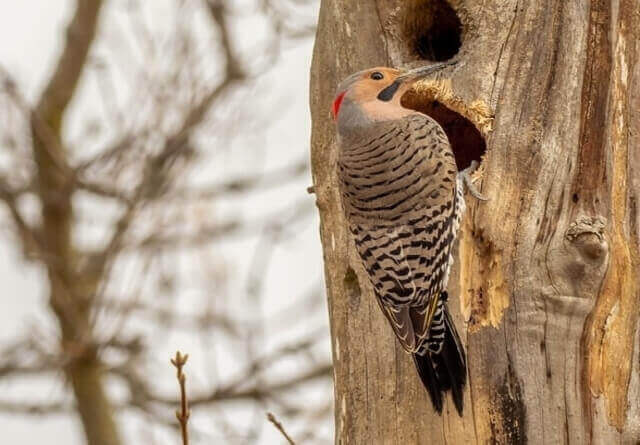
- Length: 11.0-12.0 in (28-31 cm)
- Weight: 3.9-5.6 oz. (110-160 g)
- Wingspan: 16.5-20.0 in (42-51 cm)
- Scientific Name: Colaptes auratus
- Frequency of Occurrence: 15.38%
- Maps: Range Map – Sightings Map
- Sounds: Calls and Sounds
- Where To Find Them: . The Northern Flicker is a woodpecker that can be found in Indiana during the winter. They are most commonly found in wooded areas, but can also be found in open fields and near bodies of water. The best time to see them is early in the morning or late in the evening.
- How To Attract: First, provide a food source for them. Northern Flickers are mostly insectivores, so put out a bird feeder filled with mealworms or other small insects. You can also put out a suet feeder, as they love suet cakes. Second, make sure there are plenty of trees or large shrubs for them to perch on and nest in. They love oak trees, but any type of tree will do.
General Information: The Northern Flicker is a medium-sized woodpecker with a buffy breast and black and white bars on the back. The male has a red patch on the nape of his neck, while the female has a brown patch. Both sexes have a black bib with white borders. It has a long, slightly curved bill that is black, tapering down to its base. The tail is black on the back with white outer feathers. The legs are gray.
This bird ranges throughout Canada and the United States. In the summer, it can be found in open woods, edges, parks, and gardens. In the winter, it often visits backyard feeders. The Northern Flicker feeds on ants and other insects that it finds by digging in the ground with its long bill. It also eats fruits, berries, and nuts. In winter, its diet consists mostly of seeds from trees and shrubs.
Related: How to Attract Northern Flickers to your Backyard? (Easy)
Eastern Bluebird
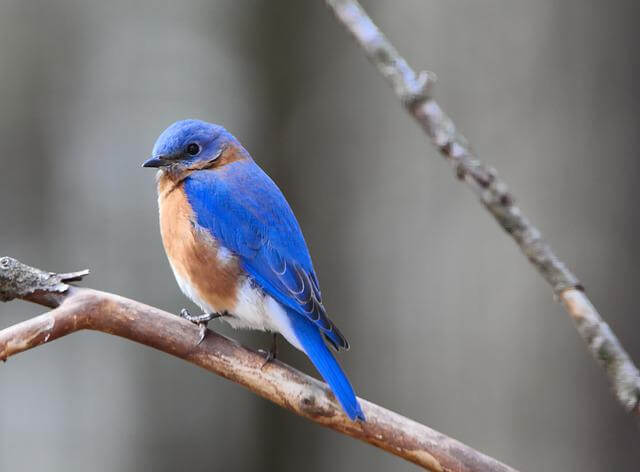
- Length: 6.3-8.3 in (16-21 cm)
- Weight: 1.0-1.1 oz. (28-32 g)
- Wingspan: 9.7-12.5″in. (25-32 cm)
- Scientific Name: Sialia sialis
- Frequency of Occurrence: 15.31%
- Maps: Range Map – Sightings Map
- Sounds: Calls and Sounds
- Where To Find Them:
- How to Attract Them: The best way to attract Eastern Bluebirds to your backyard is by providing them with food and shelter. Try putting up a birdfeeder filled with seeds or suet, and placing it near a bushes or trees. You can also build or buy a bluebird house, which should be placed 4-6 feet off the ground in an open area. If you provide these resources for the birds, they are more likely to visit your backyard during the winter months.
General Information: The Eastern Bluebird is a small thrush found in open woodlands, farmlands, and orchards. They are year-round residents in the eastern United States and southern Canada. The upperparts of the Eastern Bluebird are blue, while the underparts are rusty-red. They have white patches on their throat and belly. The wings and tail are darker blue with white bars. Male and female Eastern Bluebirds look similar.
Eastern Bluebirds eat mostly insects, especially beetles, grasshoppers, caterpillars, and crickets. They will additionally feed on fruits, berries, and seeds. In winter, they will eat more fruit than insects. You can attract Eastern Bluebirds to your yard by putting out a bird feeder with mealworms or berries. During the winter months, some Eastern Bluebirds may migrate southward.
Related: How to Attract Eastern Bluebirds to your Yard (Explained)
Hairy Woodpecker
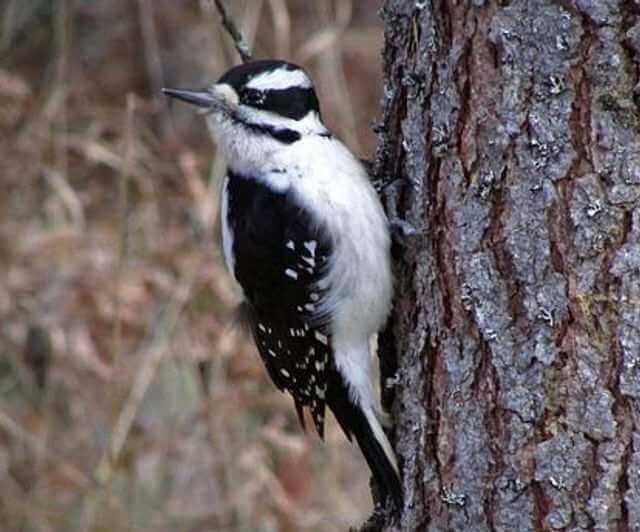
- Length: 7.1-10.2 in (18-26 cm)
- Weight: 1.4-3.4 oz (40-95 g)
- Wingspan: 13.0-16.1 in (33-41 cm)
- Scientific Name: Leuconotopicus villosus
- Frequency of Occurrence: 14.84%
- Maps: Range Map – Sightings Map
- Sounds: Calls and Sounds
- Where To Find Them: In winter, they are most commonly found in the southern part of the state near the Ohio River. They are also occasionally seen in the northern part of the state near Lake Michigan.
- How to Attract Them: Provide a good food source: Hairy Woodpeckers are mainly insectivores, so offering a variety of insects such as mealworms will be sure to attract them. If you have a suet feeder, this is an especially good way to attract them, as they love suet! Give them some shelter: Hairy Woodpeckers will often use trees for shelter, so having some large trees in your backyard will help attract them.
General Information: The Hairy Woodpecker is a medium-sized woodpecker that is found in North America. The adult Hairy Woodpecker has a black back, white underparts, and a black head with a white stripe running down the middle. The male Hairy Woodpecker also has a red patch on the back of its head. The Hairy Woodpecker ranges from 18 to 21 cm in length and weighs between 45 and 70 grams.
The Hairy Woodpecker is found in forests throughout North America. In the summer, the Hairy Woodpecker can be found in Canada and the northern United States. In the winter, the Hairy Woodpecker range extends further south into the United States. The diet of the Hairy Woodpecker consists mainly of insects and their larvae, although they will also eat fruit and nuts.
Black-capped Chickadee
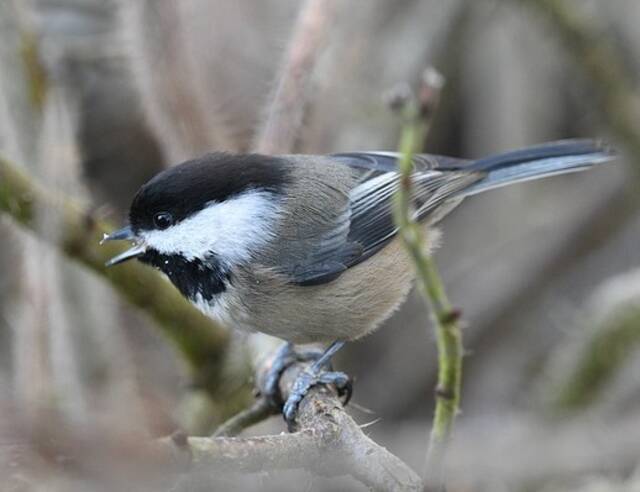
- Length: 4.7-6.0″ in (12.0-15.2 cm)
- Weight: 0.3-0.5 oz. (9-14 g)
- Wingspan: 6.3-8.3 in (16-21 cm)
- Scientific Name: Poecile atricapillus
- Frequency of Occurrence: 11.75%
- Maps: Range Map – Sightings Map
- Sounds: Calls and Sounds
- Where To Find Them: During the winter months, Black-capped Chickadees can be found in a variety of locations throughout Indiana. These birds are most commonly found in wooded areas, such as forests and parks. They also often inhabit residential areas with trees and shrubs.
- How to Attract Them: First, make sure you have some trees or shrubs nearby. Chickadees like to forage in trees and shrubs for insects. They also use trees and shrubs for shelter from the elements and predators. Second, provide a water source. A birdbath or small fountain will do. Chickadees need water to drink and bathe in. Third, offer some food. Black-oil sunflower seeds are a favorite of chickadees.
General Information: The Black-capped Chickadee is a small, sprightly bird that is a common sight in forests across North America. These birds are easily recognizable by their black cap and white cheeks, and their cheerful “chick-a-dee” call. Chickadees are year-round residents in many parts of their range, but some birds do migrate south for the winter.
Chickadees are found in a variety of habitats, including deciduous and coniferous forests, woodlands, and urban parks and gardens. They are adaptable birds that can even nest in man-made birdhouses. Chickadees mostly eat insects and other small invertebrates, but they will also eat seeds and berries. In winter, when insect prey is scarce, these birds often visit backyard bird feeders to supplement their diet.
Related: Unique Black-capped Chickadee Facts You Need To Know!
Pileated Woodpecker
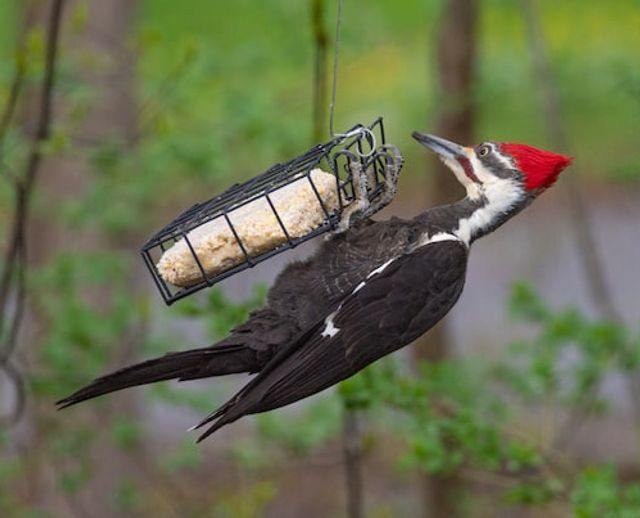
- Length: 15.8-19.3 in (40-49 cm)
- Weight: 8.8-12.3 oz (250-350 g)
- Wingspan: 26.0-29.5 in (66-75 cm)
- Scientific Name: Dryocopus pileatus
- Frequency of Occurrence: 11.45%
- Maps: Range Map – Sightings Map
- Sounds: Calls and Songs
- Where To Find Them: These birds are most commonly found in wooded areas near bodies of water, such as lakes, rivers, and wetlands. Pileated woodpeckers are also known to inhabit forests, parks, and even urban areas.
- How to Attract Them: One of the best ways to attract a Pileated Woodpecker to your backyard in winter is by putting out a suet feeder. Suet is a high-fat bird food that woodpeckers love, and it’s especially important in winter when natural food sources are scarce. You can buy suet at most pet or hardware stores, or make your own by rendering fat from beef . Another way to attract Pileated Woodpeckers is by providing a water source. In winter, birdbaths can freeze solid, so consider setting up a drip system or placing a heated birdbath in your yard. The birds will also appreciate a place to perch, so include some large branches in your landscaping.
General Information: Pileated Woodpecker: The Pileated Woodpecker is a large woodpecker that is native to North America. The Pileated Woodpecker ranges from southeastern Alaska to Nova Scotia and south to northern California and northern Florida. The Pileated Woodpecker has black plumage with white wing patches and a red crest. The Pileated Woodpecker is the largest woodpecker in North America, measuring up to 19 inches in length with a wingspan of up to 30 inches.
The Pileated Woodpecker inhabits forests with large trees. The Pileated Woodpecker nests in cavities excavated in dead or dying trees. The diet of the Pileated Woodpecker consists of insects, fruits, and nuts. Pileated Woodpeckers are year-round residents of their range.
Related: How to Attract Pileated Woodpeckers to your Yard (Fast)
Red-winged Blackbird
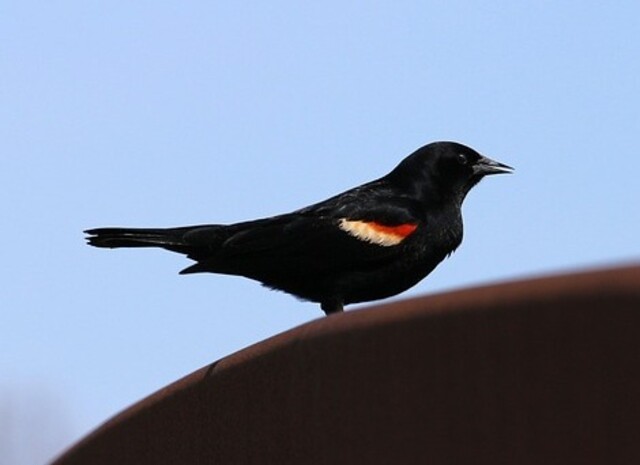
- Length:6.7-9.1 in (17-23 cm)
- Weight: 1.1-2.7 oz (32-77 g)
- Wingspan: 12.2-15.8 in (31-40 cm)
- Scientific Name: Agelaius phoeniceus
- Frequency of Occurrence: 10.56%
- Maps: Range Map – Sightings Map
- Sounds: Calls and Sounds
- Where To Find Them: In Indiana, they can be found in many different locations in winter. Some of the most common places to find them are in wetlands, marshes, and fields. They are also commonly seen in forests and woodlands.
- How to Attract Them: Provide food: Red-winged blackbirds are insectivores, so they will be attracted to yards with plenty of insects for them to eat. If you don’t have many insects in your yard, you can try supplementing their diet with bird seed mix that contains sunflower seeds, millet, and safflower seeds. Create shelter: These birds also appreciate some shelter from the cold weather. Creating a brush pile or setting up a bird house in your yard can give them somewhere to take refuge when the weather gets tough.
General Information: The Red-winged Blackbird is a species of true blackbird that ranges across most of North America. These birds are sexually dimorphic, meaning the males and females look different. The male has black feathers with red and yellow wing bars, while the female is more drab-looking with brownish feathers. Red-winged Blackbirds are found in a variety of habitats including wetlands, grasslands, and forests.
They are also common visitors to bird feeding stations. These birds eat mostly insects but will also consume fruits, seeds, and other small animals. In the winter months, Red-winged Blackbirds often form large flocks and can be seen in open fields and along roadsides.
Related Posts:


